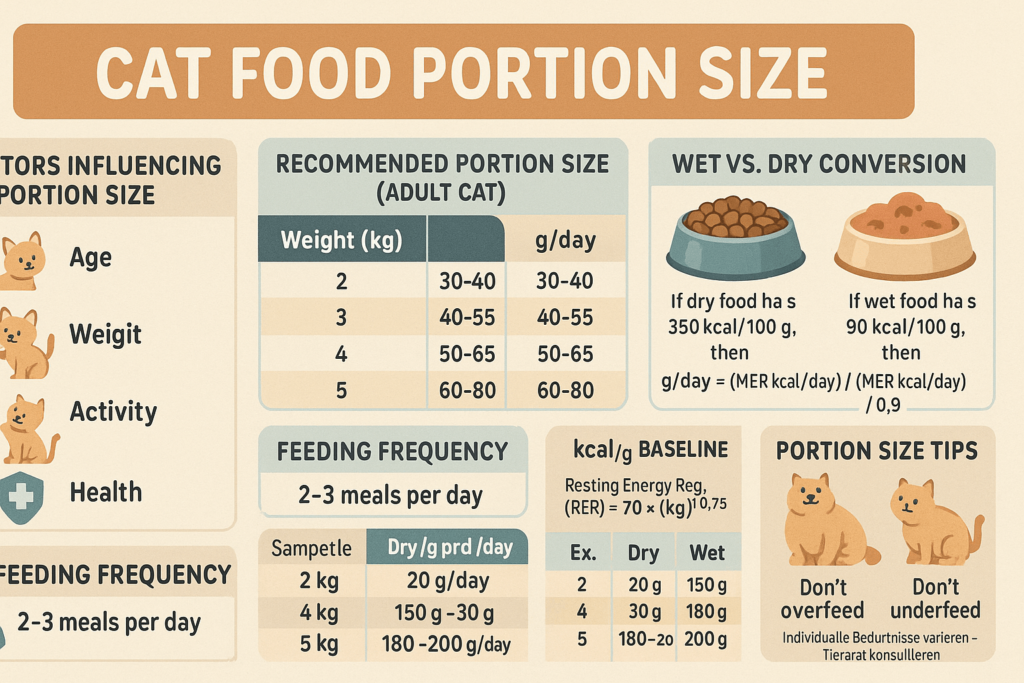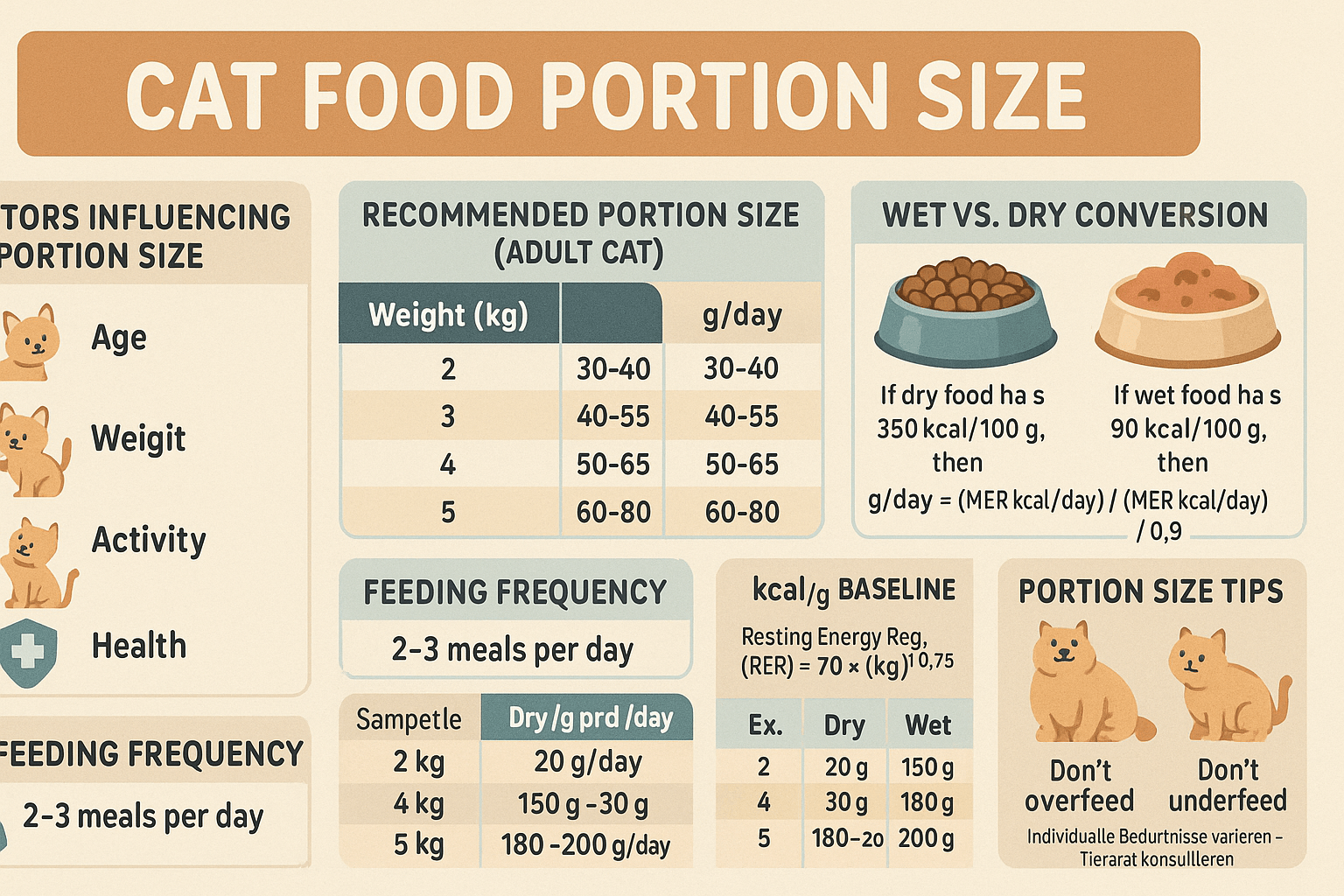Cat Food Portion Size: How Much Should You Feed Your Feline Friend?
Feeding your cat the right amount of food is essential for their health and happiness. But determining the correct portion size can be tricky, especially with so many factors to consider—age, weight, activity level, and dietary needs all play a role. Overfeeding can lead to obesity and related health issues, while underfeeding may result in malnutrition or lack of energy. Understanding how to calculate and adjust your cat’s food portions ensures they receive the balanced nutrition they need to thrive. In this guide, we’ll explore everything you need to know about cat food portion sizes, from general guidelines to personalized tips for your furry companion.
Expert Insight on Senior Cat Nutrition
“Senior cats (those more than 7 to 8 years old) often need fewer calories than adult cats if they are developing medical issues, and also to keep them from becoming overweight. Obesity is a serious medical condition that affects how much your cat can eat daily. It can lead to many health issues and puts stress on an aging cat’s joints, which makes arthritis more uncomfortable.”
Factors That Influence Cat Food Portion Sizes
Every cat is unique, and their nutritional needs vary based on several key factors. Understanding these influences helps you tailor your feeding approach to suit your cat’s individual requirements.
Age and Life Stage:
Kittens require more frequent meals and higher calorie intake to support growth, while senior cats may need fewer calories due to reduced activity levels.Weight and Body Condition:
Overweight cats may need smaller portions to encourage weight loss, while underweight cats may benefit from slightly larger servings.Activity Level:
Active cats burn more calories and may require additional food, whereas sedentary indoor cats need less to avoid overeating.Health Conditions:
Cats with medical issues like diabetes, kidney disease, or allergies may need specialized diets and adjusted portion sizes as prescribed by a vet.Type of Food:
Wet food, dry kibble, and raw diets have different caloric densities, which affect how much you should feed your cat at each meal.
Considering these factors ensures your cat’s diet is tailored to their specific needs, promoting optimal health and well-being.

General Guidelines for Cat Food Portions
While every cat is different, there are general guidelines you can follow to estimate how much to feed your feline friend. These recommendations provide a starting point for determining portion sizes.
Daily Caloric Needs:
On average, adult cats require around 200-300 calories per day, depending on their size and activity level. Divide this into two or three meals.Kitten Feeding Schedule:
Kittens should eat small amounts every 3-4 hours, gradually transitioning to regular meals as they grow older.Adult Cat Portions:
Most adult cats need about 1/2 to 3/4 cup of dry food or 5-6 ounces of wet food daily, split into two meals.Senior Cat Adjustments:
Older cats may need 10-20% fewer calories than younger adults to prevent weight gain and maintain mobility.Monitoring Weight Changes:
Regularly weigh your cat and adjust portions if you notice significant weight gain or loss.
These guidelines serve as a foundation, but always consult your veterinarian for personalized advice based on your cat’s unique needs.
Check this guide 👉Diabetic Cat Food: Best 7 Expert Tips!
Check this guide 👉How Much Does Cat Food Cost Per Month? Best 7 Tips!
Check this guide 👉Homemade Cat Food Recipes: Best 7 Expert Tips!
Signs Your Cat Is Overfed | Signs Your Cat Is Underfed |
|---|---|
Excessive weight gain | Visible ribs or spine |
Lethargy and lack of energy | Constant hunger or begging behavior |
Difficulty grooming themselves | Dull coat or hair loss |
Struggling to jump or move around | Weakness or muscle loss |
Frequent vomiting or digestive issues | Lack of interest in play or activities |
How to Measure and Serve Cat Food Accurately
Proper measurement and serving techniques are crucial for maintaining portion control and preventing overfeeding or underfeeding. Follow these steps to ensure accuracy.
Use a Measuring Cup:
Avoid eyeballing portions—use a dedicated measuring cup or scale to measure food precisely.Follow Package Guidelines:
Check the feeding instructions on your cat’s food packaging, but remember these are just estimates. Adjust based on your cat’s needs.Separate Meals Clearly:
Divide food into distinct meals rather than free-feeding, which can lead to overeating and obesity.Track Daily Intake:
Keep a log of how much food your cat consumes daily to monitor trends and make adjustments as needed.Combine Wet and Dry Food Carefully:
If feeding both types, calculate the total calories and adjust portion sizes accordingly to avoid overfeeding.
By adopting these practices, you can maintain consistency and ensure your cat receives the right amount of food each day.
Tips for Transitioning to a New Food or Portion Size
Changing your cat’s food or portion size requires patience and care to avoid digestive upset or resistance. These tips help make the transition smooth and stress-free.
Gradual Changes Are Key:
Mix small amounts of the new food with the old over 7-10 days, gradually increasing the proportion of the new food.Monitor Digestive Health:
Watch for signs of diarrhea, vomiting, or constipation during the transition period and slow down the process if needed.Adjust Portions Gradually:
Increase or decrease portion sizes incrementally to allow your cat’s body time to adapt to the change.Offer Praise and Rewards:
Encourage acceptance of new foods by offering treats or affection after successful meals.Consult Your Vet Before Major Changes:
Always seek professional advice before making significant dietary changes, especially for cats with health conditions.
A thoughtful approach to transitions ensures your cat adjusts comfortably and continues to thrive.
Common Mistakes to Avoid When Feeding Cats
Even well-meaning cat owners can make mistakes when it comes to feeding their pets. Avoiding these pitfalls ensures your cat stays healthy and happy.
Overestimating Activity Levels:
Assuming an indoor cat burns as many calories as an outdoor one can lead to overfeeding. Adjust portions based on actual activity.Ignoring Food Quality:
Low-quality food may require larger portions to meet nutritional needs, increasing the risk of overeating. Choose high-quality options instead.Not Adjusting for Age:
Failing to reduce portion sizes as your cat ages can contribute to weight gain and related health issues.Skipping Regular Weigh-Ins:
Without tracking your cat’s weight, it’s easy to miss subtle changes that indicate improper feeding habits.Giving Too Many Treats:
Treats should make up no more than 10% of your cat’s daily caloric intake to avoid unbalancing their diet.
Avoiding these mistakes helps you maintain a healthier feeding routine for your cat.
Signs Your Cat Loves Their Food
Cats are notoriously picky eaters, but certain behaviors indicate they’re enjoying their meals. Look for these signs to gauge satisfaction with their diet.
Excitement Before Meals:
A happy cat will often anticipate mealtime by sitting near their bowl or vocalizing gently.Eating Slowly and Enjoyably:
Cats who savor their food rather than gulping it down likely find it palatable and satisfying.Clean Bowl After Meals:
Finishing their portion indicates they enjoy the taste and texture of their food.Consistent Energy Levels:
A well-fed cat has steady energy throughout the day, showing enthusiasm for play and exploration.Healthy Coat and Skin:
Shiny fur and clear skin reflect proper nutrition and enjoyment of their diet.
These signs confirm your cat not only tolerates but truly loves their food.
How to Encourage Picky Eaters
If your cat turns their nose up at mealtimes, don’t worry—there are ways to encourage them to eat without compromising their health.
Warm Up the Food:
Slightly warming wet food enhances its aroma and makes it more appealing to finicky eaters.Try Different Textures:
Some cats prefer pate-style wet food, while others like chunks in gravy. Experiment to find what they enjoy.Introduce Variety Gradually:
Rotate flavors or brands occasionally to prevent boredom, but introduce changes slowly to avoid digestive upset.Create a Calm Environment:
Feed your cat in a quiet, stress-free area where they feel safe and comfortable eating.Stick to a Routine:
Cats thrive on consistency—serve meals at the same time and place each day to build trust and anticipation.
With patience and creativity, even the pickiest eaters can learn to enjoy their meals again.
Frequently Asked Questions About Cat Food Portion Sizes
How often should I feed my cat?
Most adult cats do well with two meals per day, spaced evenly apart. Kittens may need more frequent feedings.
Can I free-feed my cat?
Free-feeding can work for some cats, but it often leads to overeating and obesity. Scheduled meals are generally recommended.
What if my cat begs for more food?
Begging doesn’t necessarily mean your cat is hungry—it could be a habit. Stick to measured portions and offer toys or attention instead.
How do I know if my cat is overweight?
Look for a visible waistline and feel for ribs without pressing too hard. Consult your vet for a professional assessment.
Should I adjust portions for treats?
Yes, account for treat calories by reducing meal portions slightly to maintain balance.
Finding the Perfect Balance for Your Cat’s Diet
Determining the right cat food portion size is a blend of science and observation. By understanding your cat’s unique needs, following general guidelines, and monitoring their health, you can ensure they receive the nutrition they need to live a long, happy life. Remember, no two cats are alike, so flexibility and attentiveness are key. With careful planning and regular check-ins with your vet, you’ll create a feeding routine that keeps your feline friend healthy, satisfied, and full of energy.
Canned Pumpkin for Cat Diarrhea: Best 7 Expert Tips! Natural remedy to firm stools, soothe upset bellies, and support gut health safely.
Can a Cat Give You Scabies? Best 7 Expert Tips! Discover the truth about feline mites, human skin risks, and how to protect yourself—without panic.
Cat Flea vs Human Flea: Best 7 Expert Tips! Discover the truth about bites, species, and how to eliminate infestations for good.
Weird Cat Behaviors: Best 7 Expert Tips! Discover why cats do strange things—and how to understand, not punish, their instincts for a happier home.





